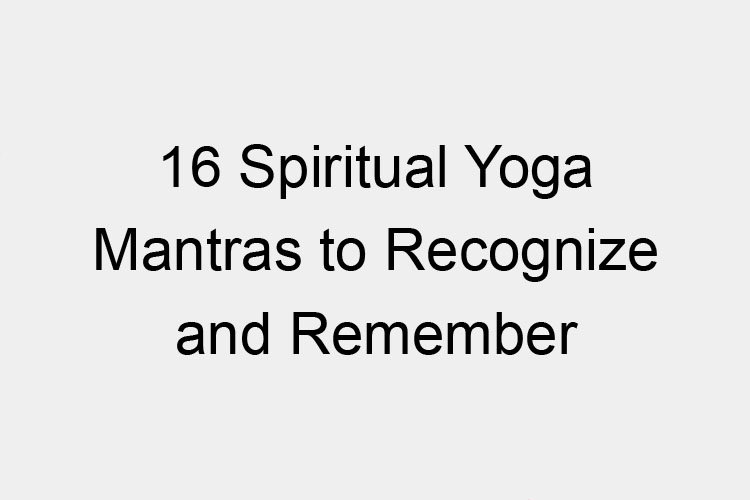

Practicing yoga is a positive journey for both your physical and mental health. Mentally, you will notice more strength to move away from negative situations. Physically, you will become more flexible and improve your posture. Here are my top six reasons to start practicing yoga.
1. Relieve Stress. One major component of yoga is meditation. Yoga meditation was designed to calm your mind and move into a deeply meditative state. This is mainly practiced in order to be more relaxed. Meditating often will help control stress, decrease anxiety, and improve your cardiovascular health. Learning to focus your mind on one thing at a time seems difficult at first, but with practice you start to develop new habits towards a more relaxed internal state. Meditating becomes easier changing your life for the better.
2. Breathe More Effectively. Yoga mainly focuses on pranayama techniques giving you the opportunity to use your entire lung capacity. Practicing enables you to learn how to breathe better. These techniques have an extremely calming effect.
3. Become Stronger Mentally. Not only will you notice that you will become more positive, but you will be able to accept whatever life brings to the table. Not all life experiences are good. Yoga teaches you that both positive and negative things in life come and go. Understanding this on a deeper level makes it easier to accept, stay present, and be positive. You will slowly become more aware of how things influence you. You will naturally make changes that will impact your life in a favorable way. Overall, you will become more aware of everything in life. Once you develop self-awareness you are able to change your thoughts and interpretations.
4. Become Stronger Physically. Yoga is a full body workout that targets muscles within the body through specific poses and postures. Yoga increases mobility and flexibility bringing more ease into your movement. Essentially you won’t feel so stuck within your body. You will notice that your posture will improve.
5. Be in the Present. People tend to get bogged down thinking about the past or the future and in today’s society checking out completely into the land of cell phones or social media however, yoga gives you the ability to unplug and focus on what is going on in your body and in your life right now. Happiness can only be found here and now in the present.
6. Manage Your Pain. Studies suggest that practicing yoga reduces pain for people with conditions including hypertension or arthritis cancer.
Do you practice yoga? Will you consider trying a yoga class after hearing these benefits?
Similar Blog Posts:
- 10 Reasons to Practice Self Care10 Reasons to Practice Self Care Self-care refers to activities and practices that support your overall well-being. Practicing can help maintain your physical and mental health and reduce stress. Below are 10 reasons to practice self-care. Examples of Self Care: -Write in a journal to release emotions and reflect on your day.-Go for a walk… Read more: 10 Reasons to Practice Self Care
- 10 Reasons to Set Goals10 Reasons to Set Goals Setting goals is vital for personal growth. I always say that if you are going to set goals, you also have to create a step-by-step plan to achieve that goal. I will write a future post on ways to accomplish your goals, but here we share 10 reasons to set… Read more: 10 Reasons to Set Goals
- 10 Habits to Begin Before the New YearWhen is the best time to start preparing for the new year? Well, it is never too early or too late to start! Below are 10 habits to start before the new year for a smooth transition.#1: Start Waking Up Earlier and Stick to a Consistent Sleep Schedule#2: Drink More Water#3: Create a Daily To-Do… Read more: 10 Habits to Begin Before the New Year
- Self Care Bucket ListTaking care of yourself is great for your physical and mental health. Self-care can help reduce stress and anxiety. Below is a self-care bucket list we created to help you get started on your journey! Light Scented Candles Go to a Spa Read a Book Digital Detox Hot Tub Keep a Journal for 365 Days… Read more: Self Care Bucket List
- 5 Reasons to Have a Planner5 Reasons to Have a Planner Planners are great to add to your life because they can help you reach your goals!!! Jotting down your to-do lists, upcoming events, and daily schedule can help you stay organized. Not only can you set individual and professional goals, but you can create an action plan and keep… Read more: 5 Reasons to Have a Planner
- 60 Journal Ideas60 Journal Ideas Keeping a journal can reduce stress and anxiety. Journaling can help organize your thoughts! Below are 60 journal ideas to help you get started! Personal: 1-Goals and Resolutions 2-Things You Love 3-30 Before 30 list 4-Your Bucket List 5-Facts About Yourself 6-Currently Doing 7-Gratitude List 8-Self Care Ideas 9-Weekly, Monthly, Yearly Planner… Read more: 60 Journal Ideas
- 14 Reasons to Be Grateful!14 Reasons to Be Grateful! There are many reasons to be thankful and things to be grateful for. The benefits of being grateful include having better sleep, improved physical and mental health, and healthier relationships. Focusing on the good in your life can create positive feelings about yourself. Showing appreciation can strengthen your relationships and… Read more: 14 Reasons to Be Grateful!
- Top 5 Skin Care ProductsTop 5 Skincare Products Our posts may contain affiliate links, which means I’ll receive a commission if you purchase through my link, at no extra cost to you. Taking care of your skin and having a routine in the morning and night is so good for you both mentally and physically. Mentally, washing your face… Read more: Top 5 Skin Care Products
- What Is Included in Our NEW Monthly Planner?What Is Included in Our NEW Monthly Planner? We just launched our very own MONTHLY planner! “If you fail to plan, you are planning to fail”- Benjamin Franklin Get started today towards your hopes and dreams with our MONTHLY planner. Good things will come to you if you finish the steps on your to-do list toward… Read more: What Is Included in Our NEW Monthly Planner?
- Self-Care Bullet Journal IdeasSelf-Care Bullet Journal Ideas **Our posts may contain affiliate links. I’ll receive a commission if you purchase through my link. There is no extra cost that you have to make.** As I stated in my previous post called 15 Self-Care Essentials, self-care is necessary for your physical and mental health. One form of self-care is… Read more: Self-Care Bullet Journal Ideas
- Top 15 Self-Care EssentialsTop 15 Self-Care Essentials Our posts may contain affiliate links. I’ll receive a commission if you purchase through my link. There is no extra cost that you have to make. Taking care of yourself is essential to feel your best. It is important for both your physical and mental health. Self-care can help you manage… Read more: Top 15 Self-Care Essentials
- 8 Reasons to Start Working Out with Chloe Ting8 Reasons to Start Working Out with Chloe Ting Chloe Ting is a great fitness instructor on YouTube. She has videos for beginners to advanced. She always offers modifications to each workout too. Below are 8 reasons to start working out with Chloe Ting on YouTube! Reason #1: You will feel better afterward- Exercising releases… Read more: 8 Reasons to Start Working Out with Chloe Ting
- How Drinking Water Aids in Weight LossHow Drinking Water Aids in Weight Loss Drinking water is the utmost important step that aids in weight loss. Water is 100% calorie-free and can help you suppress your appetite before meals. -Drinking Water Increases Your Metabolic Rate- Most of our metabolic processes take place in the presence of water. Water helps in the digestion… Read more: How Drinking Water Aids in Weight Loss
- 5 Reasons to Download EvernoteTop 5 Reasons to Download Evernote Making a to-do list is essential for success. Evernote allows you to organize your tasks effectively. You can save everything at your fingertips and access Evernote from your iPhone or your computer. 1- Save Your Notes in One Place- Taking notes relieves stress, helps you keep your schedule intact,… Read more: 5 Reasons to Download Evernote
- 5 Ways to Have a Positive Outlook on Life5 Ways to Have a Positive Outlook on Life Life has many obstacles and uncertainties; however, it is important to have a positive outlook on life. Before are 5 ways to have a more positive outlook on life. 1. Exercise- Exercising is a great way to relieve stress because it releases endorphins. It will change… Read more: 5 Ways to Have a Positive Outlook on Life
- 5 Minute Stretch to Do Every Day5 Minute Stretch to Do Every Day Why is stretching important? Stretching keeps your muscles strong, healthy, and flexible. The results of stretching every day are a feeling of increased muscle control and range of motion. What are the benefits of stretching? -Improve posture -Improve joint range of motion -Increases flexibility -Increases blood flow to… Read more: 5 Minute Stretch to Do Every Day
- 5 Tips for Participating in the Color RunWhat is the Color Run? The company’s mission is to bring people together and make the world happier and healthier. The Color Run partners with local charities to help raise money for various causes. The non-profit has donated more than $5 million to charities since 2012. The Color Run is a 5 km race. At… Read more: 5 Tips for Participating in the Color Run
- 5 Different Types of Goals to CreateSetting goals is super important, as this is the first step that can help you get to where you want to be in your life. We are going to list five different types of goals to set so that you can achieve a well-balanced life at both work and at home. You can do anything… Read more: 5 Different Types of Goals to Create
- 7 Ways to Make Your Home More ComfortableHome is one of the best feelings in the world. There is nothing quite like it, as you are met with pleasant smells and relaxation. The best ways to make your home more relaxing so that you can take a deep breath and simply decompress are to add more plants, play relaxing music, light candles,… Read more: 7 Ways to Make Your Home More Comfortable
- 6 Ways to Relieve Stress and the Effects It Has on the BodyThis post may contain affiliate links, which means I’ll receive a commission if you purchase through my link, at no extra cost to you. What is Stress? Stress is defined as a state of mental or emotional strain caused by unfavorable circumstances. The physical and emotional reaction commonly occurs when people experience a change in… Read more: 6 Ways to Relieve Stress and the Effects It Has on the Body
- Top 10 Goal Setting Mistakes to AvoidSetting goals are important, as it helps you organize your time and resources so that you can make the most out of life. It gives you motivation and creates a vision of how you want your life to look. The benefits are endless, as it will not only inspire you, but it will also set… Read more: Top 10 Goal Setting Mistakes to Avoid
- 6 Tips for Finding a Purpose in LifeWhen we think of our purpose, chances are we think of big goals and achievements. In reality, living with purpose is not about accomplishing goals or our to-do lists but rather living a meaningful life is about finding purpose in everyday moments. Your life purpose is something you have always known either consciously or unconsciously.… Read more: 6 Tips for Finding a Purpose in Life
- Growth Mindset- How to Change Your Thoughts…1. INSTEAD OF THINKING: I can’t do it THINK THIS:I’m still learning, I’ll keep trying 2. INSTEAD OF THINKING:I am not good at this THINK THIS:What can I learn to get better at this? 3. INSTEAD OF THINKING:I’m afraid of making a mistakeTHINK THIS:Mistakes are how I learn and get better 4. INSTEAD OF THINKING:This… Read more: Growth Mindset- How to Change Your Thoughts…
- Happy Chemicals and How to Activate ThemDopamine (Reward Chemical)- Completing a task, celebrating goals and wins, eating and drinking well, self-care activities, trying something newOxytocin (Love Hormone)- Spending time with your pet, physical touch, helping others, giving compliments, showing kindnessSerotonin (Mood Stabilizer)- Meditating, spending time in nature, get some sun exposure, exercise, mindfulnessEndorphin (Pain Killer) Exercise, essential oils, listen to music… Read more: Happy Chemicals and How to Activate Them
- 31 Journal Prompts and 10 Gratitude PromptsWriting in your journal and expressing gratitude are excellent ways to take care of your mental health. Below you will find 31 journal prompts as well as 10 gratitude prompts to answer for yourself! JOURNAL PROMPTS1. What are you most looking forward to?2. Three goals for this month3. Something that you’re looking forward to4. Describe… Read more: 31 Journal Prompts and 10 Gratitude Prompts
- 11 Interesting Facts About YogaPracticing yoga can not only benefit you physically, but also emotionally and spiritually. Yoga is a combination of breathing patterns, meditation, and different postures. Practicing has various benefits for your mind, body, and soul. Listed below are are eleven facts about yoga: There are 84 classic Yoga Asana’s. Yoga breathing is called ‘Pranayama’. Yoga reduces… Read more: 11 Interesting Facts About Yoga
- 7 Interesting Facts About Running7 Interesting Facts About Running Running burns calories, builds muscle, busts stress, and boosts your heart health. The benefits are endless. All you have to do is grab a pair of sneakers and go! Listed below are some interesting facts about running to know! FACTS:1. Running outside at the same pace as on the treadmill… Read more: 7 Interesting Facts About Running
- 9 Benefits of Drinking WaterDrinking plenty of water will improve your immune system. Our bodies have 50% to 65% of water content and it is recommended that we drink six to eight glasses of water per day. This will help us perform our best, stay hydrated, and give us energy. Drinking the recommended amount of water can also aid… Read more: 9 Benefits of Drinking Water
- How Practicing Gratitude Can Help Change Your Negative EmotionsPeople who practice gratitude have more positive emotions. Gratitude teaches us to appreciate the value of people, places, food, and even materialistic things. We are less likely to take things for granted. People who have high levels of gratitude have low levels of resentment and envy. This is because you cannot feel envious and grateful… Read more: How Practicing Gratitude Can Help Change Your Negative Emotions
- Yoga Tips for BeginnersYoga is one of the best forms of exercise, as it has a lot of benefits towards not only a healthy body, but a peaceful mind. This article will give you five tips to help you get started with your practice. Invest in a good yoga mat- A yoga mat is more than just an area… Read more: Yoga Tips for Beginners
- 6 Tips for Manifesting Your FutureManifestation Blog Post What is Manifestation? Manifestation is where your thoughts and energy can create your reality. It is not only believing in yourself, but also in what you want out of life and knowing that you can accomplish it. Once it is real in your head then it is more likely to become real… Read more: 6 Tips for Manifesting Your Future
- 38 Lists to Make When Life Gets Overwhelming38 Lists to Make When Life Gets Overwhelming Making a list will help you focus and actually get things done. Crossing off items off of your to do list will stimulate a release of dopamine. Dopamine is what allows you the emotion of accomplishing a task. It is a good feeling that can help you… Read more: 38 Lists to Make When Life Gets Overwhelming
- 4 Reasons to Start a Journal4 Reasons to Start a Journal Having a journal can help you have a better connection with your values, emotions, goals, and dreams. Journaling what you believe in, why you believe it, how you feel, and what your goals are can help you be more clear about life in the present moment, what you want… Read more: 4 Reasons to Start a Journal
- 16 Ways to Grow as a PersonThe goal in life is to be a good listener, help others, and have respect for one another. Be a good listener– Listen with all of your attention. Practice to not give opinion or advice unless asked. When you are in a disagreement with someone it is important to hear them out fully. This helps… Read more: 16 Ways to Grow as a Person
- 12 Tips to Change Your Mood to a More Positive OneHow do you change how you feel? This might seem impossible, as you might feel as though the world is ending, but it is certainly not. There are many ways to feel better about yourself and life. Some of them need work over a long period of time, however it is possible to feel less… Read more: 12 Tips to Change Your Mood to a More Positive One
-
 Custom Tote Bags$225.00
Custom Tote Bags$225.00 -
 Sprinkles Headband$8.00 – $10.00
Sprinkles Headband$8.00 – $10.00 -
 Turquoise Headband$8.00 – $12.00
Turquoise Headband$8.00 – $12.00 -
 Aqua Headband$8.00 – $12.00
Aqua Headband$8.00 – $12.00 -
 Blue Pizza Headband$8.00
Blue Pizza Headband$8.00 -
 Rila Fleece
Rila Fleece -
 Dara Fleece$12.00
Dara Fleece$12.00 -
 True Love Twist$10.00
True Love Twist$10.00 -
 Boracay Colorband Twist$10.00
Boracay Colorband Twist$10.00

















































 The online community of yoga blogs filled with information about yoga, meditation, and wellness is massive. I have narrowed down a list of my favorite yoga blogs that are constantly updated and have a significant amount of readers. Each blog provides the yoga community with value, as they share well-written articles, workshops, yoga classes, videos, free yoga challenges, and more. Here are a few gems that I think stand out the most.
The online community of yoga blogs filled with information about yoga, meditation, and wellness is massive. I have narrowed down a list of my favorite yoga blogs that are constantly updated and have a significant amount of readers. Each blog provides the yoga community with value, as they share well-written articles, workshops, yoga classes, videos, free yoga challenges, and more. Here are a few gems that I think stand out the most.